
1. After all the preliminary work and decision making based on the assessment, the time comes to purchase the device and implement it to meet the student's learning outcomes. Once the IEP team determines what device is needed to be used tor the student then it is implemented. Once the device has been attained for the student, additional training may be necessary if the device is different from the one used in the trial period.
2. Step Three: The Individualized Education Program Team
2.1. The IEP team, which is multidisciplinary in nature, will make its decisions based on the report given by the AT specialist and in light of other information found in the student's IEP. The team should carefully consider the student's learning goals and see how the AT allows the student to access the curriculum.This team makes decisions on what types of devices to use. Also the IEP team makes decisions on training needs for the student and for those working with the student. This includes the family. Training issues should be discussed and decisions made at the time the IEP is developed.
2.2. Device Trials: After the team decides that the student needs AT for access and support and determines the device or devices the student may need, it is time for the team to procure the device. Because many devices are high tech and expensive, the team should research the devices they consider. Failure to do so may result in overspending or underspending. The team should try to use the device on a trial basis.
3. Step Four: Implementation of the Assistive Technology Device.
4. The Four Step Process for Referral and Assessment for Assistive Technology
5. Step One: Referral for Assistive Technology Assessment
5.1. District's Form
5.1.1. This may be an initial referral, a referral of a transferring student, or a request for a student already receiving special education services. A family member, a referring agency, a physician, a teacher, or another school professional may make the referral.
5.1.1.1. The team will want to organize and consider the following information: • Student data or personal information • Medical data for vital concerns • Vision and hearing reports • Information about any technology or equipment currently in use • Background information regarding any related services provided previously for the student
6. Step Two: Conducting Assistive Technology Assessment
6.1. Direct Observation:
6.1.1. During direct observation, the AT specialist spends time focused on observing the student's abilities and skills, including the following: Cognitive skills Current use of any AT devices Sensory skills Motor skills Communication skills Social skills For the older student with a disability receiving transition services, the specialist may wish to observe independent living skills and vocational performance. When very young children with disabilities are assessed, it is helpful to include a family assessment.
6.2. Interviews
6.2.1. Interviews allow the specialist to gather information about specific areas of interest and give parents, teachers, and the student opportunities to express their experiences, interests, and concerns. AT specialists may develop their own interview questions. these interviews can yield a wealth of useful information, including the following: Family concerns and expectations. Perceived needs and abilities of the student. Academic expectations. Diagnostice information. Medical information.
6.3. Formal Assessment
6.3.1. A formal AT assessment involves selected activities in predetermined environments. One area of need in AT is the development and publication of formal AT instruments. Because these instruments are scarce, the AT specialist may use instruments that were not designed specifically for assessing AT but that allow inferences to be made about how the student's skills are interrelated with the need for AT.
